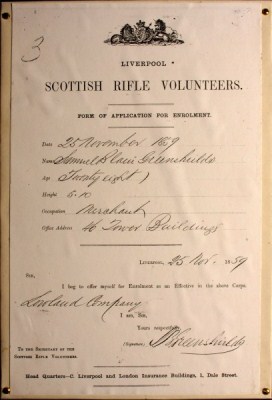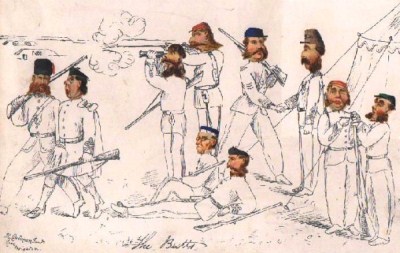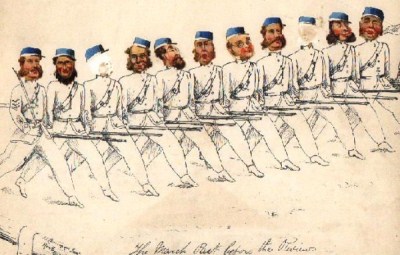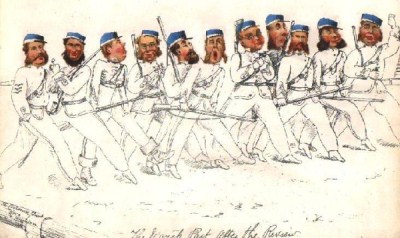The Victorian Era
The Victorian Volunteer Movement (pre -1900)
 In 1859 the United Kingdom was threatened with invasion by Napoleon III of France. This led to the raising of Rifle and Artillery Volunteer Corps for the purposes of meeting such an invasion. Queen Victoria signified her acceptance of a Corps of Volunteers under the title of 'The Liverpool Scottish Rifle Volunteers (XIXth Lancashire)'. There were two companies, a Lowland company and a Highland company, which wore the MacKenzie tartan. These units were, in general, equipped and maintained at their own expense; members paid a subscription and bought their own uniforms and, in many cases, their commanders maintained them at their own expense. William Brown, a great commercial power in Liverpool, raised and commanded the 1st. Liverpool Artillery Volunteers at the age of 75 and is reputed to have contributed £3000 per annum to their expenses (a figure that is equivalent to over £300,000 today).
In 1859 the United Kingdom was threatened with invasion by Napoleon III of France. This led to the raising of Rifle and Artillery Volunteer Corps for the purposes of meeting such an invasion. Queen Victoria signified her acceptance of a Corps of Volunteers under the title of 'The Liverpool Scottish Rifle Volunteers (XIXth Lancashire)'. There were two companies, a Lowland company and a Highland company, which wore the MacKenzie tartan. These units were, in general, equipped and maintained at their own expense; members paid a subscription and bought their own uniforms and, in many cases, their commanders maintained them at their own expense. William Brown, a great commercial power in Liverpool, raised and commanded the 1st. Liverpool Artillery Volunteers at the age of 75 and is reputed to have contributed £3000 per annum to their expenses (a figure that is equivalent to over £300,000 today).
The history of these units is not quite as a simple as the paragraph above suggests.
On the 15th November 1859. a meeting was held in the George Hotel. Dale Street at which a resolution was passed to raise a Corps of riflemen A committee was appointed to organise the formation and the Liverpool Scottish was born.
The first enrolled members were to form No 1 Lowland Company, soon followed by No 2 Highland, and then. No 3 Lowland Company.
Once up to it's minimum strength, the service of the Corps was offered to the War Office. Her Majesty the Oueen, giving her approval on the 10th January 1860. The Corps was accepted as the 19th Corps of Lancashire Volunteer Rifles. Uniform was to be dark grey tunic with red facings and Urquhart tartan trews for the Lowland Companies and Dark grey doublet and Mackenzie trews for the Highland Coy A. with the diced forage cap of 42nd Regiment pattern worn by all members. Headquarters were established at No 4 Great George's Square with the officers selected being:-
- Capt-Commandant George Alexander Mackenzie
- Captain Janes Maxwell
- Captain James Muir Dowie.
But all was not well within the Corps. The Highland Company waited kilts as their full dress, and had formed with this assurance, the committee now reneged on this promise and insisted on trews for the whole Corps. As a consequence most of the Highland Company members resigned in protest
The highlanders then called their own meeting and resolved to form a new kilted Highland Company. Which was to be accepted to the 71st Lancashire Rifle Volunteer Corps (1st Liverpool Highland Company), with Captain John Scott comanding. Dress was to be a fawn grey kilt and tunic, with blue facings, and Dunkeld bonnet.
This however did not satify the members of the 71st who wished to wear a tartan and again there was a secession. This resulted in a 2nd Liverpool Highland Coy being raised. This new company was accepted as the Highland Company of the 79th Lancashire R.V.C. and was commanded by Captain Robert Lamont. Dress was a fawn grey doublet with Malcolm kilt and Glengarry bonnet.The ranks of this company were swelled when they were joined by members of the ''Birkenhead Scottish'' who came across the Mersey, when the Lord Lieutenant of Cheshire refused to let Birkenhead men adopt the kilt.
By 1862, the days of the multiple small Corps were over, and each unit attempted to form battalions. The Scots of Liverpool again attempted to join together with the 2nd Liverpool Highland Company joining the 71st, however a reconciling with Lowlanders of the 19th LRV proved impossible. So the pruposed formation of a Scottish Regiment failed. The 19th Corps consolidated into the 5th LRV (Liverpool Rifle Brigade) as its ''B'' & ''C'' (Scottish) companies and disappeared.
The 71st continued life for a couple more years, gradually declining in strength, and was finally disbanding in 1864.Thus ending for the time being the aspirations of the Scottish community to have a Corps in Liverpool.
A Social or a Military Activity?
The Rifle Volunteer movement placed great emphasis on shooting and drill (and, apparently, conviviality) as three Victorian sketches with their cut-out caricature heads below might suggest. They are 'The Butts', the immaculate drill of 'The March Past Before the Review' (sadly with some headless warriors) and the rather less orderly 'March Past After the Review'. The faces are respectable, well-fed and professional, perhaps reflecting the Volunteer movement of the time.
 The 'Liverpool Scottish Rifle Volunteers (XIXth Lancashire)' were raised in 1859. The cards (not showing the Liverpool Scottish but the other rifle volunteers unit) below bear the imprint of 'J.C. Dollman Junior of Hove, Brighton'. The coloured heads have been cut out from card and the facial features are rendered in high quality print with a certain amount of embossed relief. They presumably represent volunteer life in sunnier and more southern climes than Liverpool. The interest is in the reflection they give of the perception of the Volunteer Movement at the time. It seems to be perceived as a pleasant and convivial activity of gentlemen discharging their duty as citizens as well as their rifles (occasionally). However, it is certain that the citizens of Liverpool took their military duties in 1860 seriously enough to establish rifle ranges at Altcar described as 'second only to those at Bisley. The detailed nature of the faces is of interest and it is possible that they are caricatures of local Brighton worthies or politicians of the time. Any information regarding their identity would be gladly received.
The 'Liverpool Scottish Rifle Volunteers (XIXth Lancashire)' were raised in 1859. The cards (not showing the Liverpool Scottish but the other rifle volunteers unit) below bear the imprint of 'J.C. Dollman Junior of Hove, Brighton'. The coloured heads have been cut out from card and the facial features are rendered in high quality print with a certain amount of embossed relief. They presumably represent volunteer life in sunnier and more southern climes than Liverpool. The interest is in the reflection they give of the perception of the Volunteer Movement at the time. It seems to be perceived as a pleasant and convivial activity of gentlemen discharging their duty as citizens as well as their rifles (occasionally). However, it is certain that the citizens of Liverpool took their military duties in 1860 seriously enough to establish rifle ranges at Altcar described as 'second only to those at Bisley. The detailed nature of the faces is of interest and it is possible that they are caricatures of local Brighton worthies or politicians of the time. Any information regarding their identity would be gladly received.
The Butts
This reflects the emphasis placed on shooting in the Volunteer Movement. The rifle, as opposed to the smooth-bore musket, was a fairly recent technical innovation and gave rise to specialist regular units such as The Rifle Brigade. The adoption of the Minie rifle raised the profile of the rifleman as the weapon was much easier to load than the rifles of Napolionic times. However despite the military activity, it is obvious that a certain degree of social activity is taking place.It is assumed that the kilted figure in 'The Butts' is a member of The London Scottish Rifle Volunteers (and a further card, not shown, represents The London Scottish marching in line). The Altcar Ranges, in the sand dunes on the coast between Liverpool and Southport, were established in 1860 to accommodate the rush of citizens to arms and thrives today. The activities of the Volunteer movement are depicted in several contemporary prints such as 'The Camp at Crosby' and 'The Volunteer Games at Liverpool'
The March Past Before the Review 
All is in order for this march past (though age has taken its toll on some of the pasted heads. the volunteers are in step, rifles are carried uniformly horizontal at the 'trail'.
However ......... some time later ....
 The March Past After The Review
The March Past After The Review
A rather more relaxed attitude seems in evidence. The Senior NCO on the left has his hand in his pocket, the man to his left apparently with a pipe, a yawn in the middle of the front rank and the left guide (on the viewer's right) is seemingly raising his glass to the artist as he passes. The step seems less than uniform and the rifles are being trailed at rather less than regimental angles. Territorial officers and NCOs of the subsequent 150 years might still occasionally identify with these problems.
These prints do not belong to the Liverpool Scottish Museum but are part of a private collection to which the Museum has access.
Rifle Volunteer Corps Items
A number of Items were held by the museum images of them can be seem below.
Previous page: Brief History of the Liverpool Scottish
Next page: The Volunteer Force and the Territorial Force





















